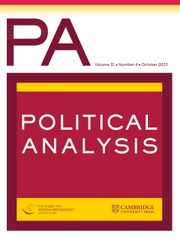Article contents
A New Measure of Congruence: The Earth Mover’s Distance
Published online by Cambridge University Press: 22 February 2017
Abstract
Scholars of representation are increasingly interested in mass–elite congruence—the degree to which the preferences of elected elites mirror those of voters. Yet existing measures of congruence can be misleading because they ignore information in the data, require arbitrary decisions about quantization, and limit researchers to comparing masses and elites on a single dimension. We introduce a new measure of congruence—borrowed from computer science—that addresses all of these problems: the Earth Mover’s Distance (EMD). We demonstrate its conceptual advantages and apply it to two debates in research on mass–elite congruence: ideological congruence in majoritarian and proportional systems and the determinants of congruence across countries in Latin America. We find that improving measurement using the EMD has important implications for inferences regarding both empirical debates. Even beyond studies of congruence, the EMD is a useful and reliable way for political scientists to compare distributions.
- Type
- Articles
- Information
- Copyright
- Copyright © The Author(s) 2017. Published by Cambridge University Press on behalf of the Society for Political Methodology.
Footnotes
Authors’ note: We are grateful to Manuel Alcántara, Matt Golder, and Juan Andrés Moraes for generously sharing their data, and to Andy Eggers, Alicia Fernández, Scott Gehlbach, Álvaro Gómez, Luis Schiumerini, Alex Tahk, Simon Urbanek, and seminar participants at Oxford and Wisconsin for helpful feedback. Previous versions of this paper were presented at the annual meetings of the European Political Science Association, Political Methodology Specialist Group of the Political Studies Association, and Society for Political Methodology. For replication materials, see Lupu, Selios, and Warner (2016). Supplementary materials are available in an online appendix on the Political Analysis website.
Contributing Editor: Jonathan Katz
References
- 37
- Cited by




